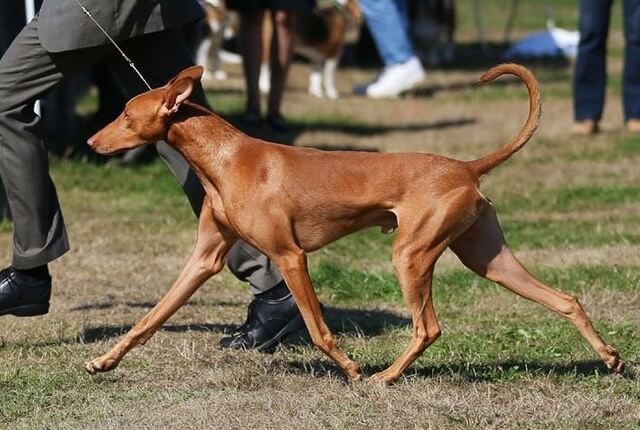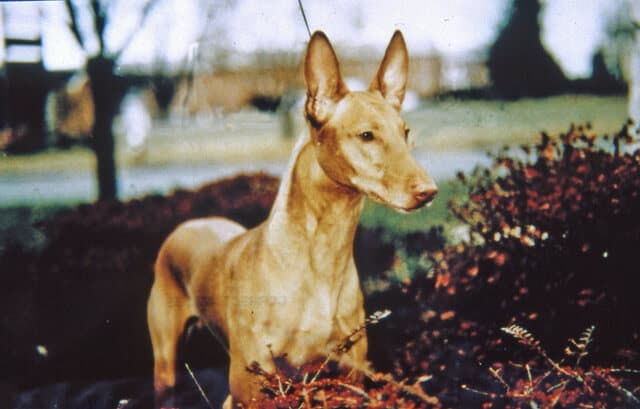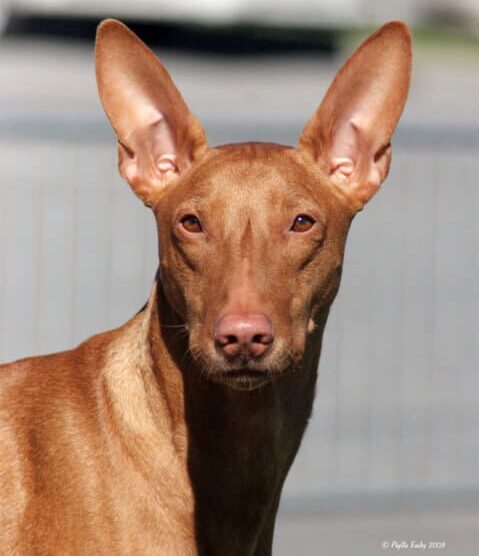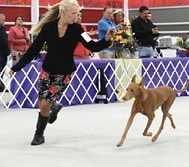
Home » Pharaoh Hound – ‘Quick Hit’ Judging Considerations

The Pharaoh Hound is fortunate to have a well-written, descriptive, yet concise Breed Standard that was created based upon the tried and true “form follows function” perspective. Our Standard contains several nuances that are not common to any other Hound breed. In this article, the Pharaoh Hound Club of America Judges’ Education Committee wishes to quickly hit on several overarching elements of our Standard from which we have seen notable deviations in recent years, and which we hope to see judges contemplating and prioritizing. Correctness in these areas is key to breed function as well as classic, unmistakable, and unique breed type.
An element of the Pharaoh Hound Breed Standard that is both unique and objective is the description of correct breed proportions: “Length of body from breast to haunch bone slightly longer than height of withers to ground.” Where numerous Standards for other breeds call for “slightly longer than tall” proportions, the Pharaoh Hound Standard explicitly defines point-to-point length measurements.
When viewed in profile from across the ring, a correctly proportioned Pharaoh Hound will resemble a rectangle only slightly more than a square. This is because length measurement must be taken from the forechest (breast) to the point of buttocks/ischium (haunch bone). It is important to note that the Pharaoh Hound’s length is not in the back or loin (as we see an increasing number of long bodies with overly rectangular profiles), potentially leading to a lack of agility as well as topline issues.
Another priority apparent in a Pharaoh Hound’s profile is balance. The Standard stresses, “All-over balance must be maintained.” The shoulder is well laid back, with a smooth transition of strong neck into shoulders, and the rear is equally angled to the front with only a moderate sweep of stifle. A high neck, which sets abruptly into an upright shoulder, paired with an over-angled rear assembly (wherein the perpendicular hocks fall significantly behind the point of buttocks) is often seen as “flashy” construction, but is not breed-typical or balanced and will absolutely lead to incorrect movement.
Correct Pharaoh Hound movement is a direct result and culmination of correct proportions and balance, and should be considered one of the highest priorities in judging. Though capable of intense speed when in double suspension, the breed spends much more time functioning as an endurance trotter as it hunts. The efficiency of gait is therefore paramount.
A correctly balanced Pharaoh Hound will be so efficient, smooth, and effortless in its gait that nothing will appear “flashy” or otherwise draw one’s eye in any overt manner (such as any lifting or hackney action in front, overreaching, or upwards kicking motion in the rear).
This is not a breed meant to be raced around the show ring or one that should be rewarded for TRAD (tremendous reach and drive), since it comes at the expense of effortless, sound movement. When moving about the ring, the Pharaoh Hound’s topline should remain level in motion, with minimal bounce; imagine a full cup of water resting on the Pharaoh’s back without spilling.

When coming and going, both front and back legs should move in-line with the body. Ideally, you should see only one set of legs, and the legs should remain close to parallel (save a slight natural convergence at higher rates of speed). This is a breed that should never single-track, crab, throw elbows, or flip pasterns—all actions which indicate a lack of working balance between the front and rear angulation.
Though not as important from a functional standpoint as the aforementioned proportion, balance, and movement, the Pharaoh Hound head is certainly a key element of correct, aesthetically pleasing breed type and should not be overlooked. While our Breed Standard provides very specific guidelines for how to judge the Pharaoh Hound head, there is some room for subjectivity, since differing heads may be marginally different yet equally correct. However, we are seeing an increasing number of Pharaoh Hounds being shown with objective head faults that significantly detract from the unique breed type.
Correct Pharaoh Hound head shape should resemble a “blunt wedge” when viewed both head-on and in profile. This requires a strong underjaw extending all the way to the end of the nose. This differs from some related Mediterranean breeds. For example, the Ibizan Hound Standard specifically calls for the nose to be “…prominent, extending beyond the lower jaw.” Also necessary for the blunt wedge shape of the Pharaoh Hound are parallel head planes and a slight, but readily apparent, stop. A lack of underjaw (giving the muzzle a far too “pointy” look), as well as exhibits that are down-faced and/or Roman-nosed with both too little AND too pronounced a stop, all detract from the desired blunt wedge head shape and required “alert… keen intelligent” expression.

Pharaoh eyes are distinctive in that they are oval in shape and amber in color. The exact shade of amber permitted depends on the coat color, but should always blend. A round and/or light-colored eye (except in a puppy where eyes typically start out light gold and gradually darken into maturity) significantly changes the required keen, alert, intelligent expression.

Our Standard calls for a “medium high” ear-set, wherein the outer edge of the ear continues the lines of the blunt wedge formed by the muzzle/cheeks when viewed head-on. High-set, almost parallel, ears, though correct for the Cirneco dell’Etna (the Cirneco Dell’Etna Standard states: “Set very high and close together, erect and rigid, parallel or almost parallel when alert.”), are a definite fault in a Pharaoh Hound—but a fault we are seeing with increasing frequency in exhibits.
Keeping these points at the fore when judging a broad entry of Pharaoh Hounds will not only help to separate the good from the great, it will also help to identify the most excellent examples of the breed; the ones that adhere to a Breed Standard which was developed based on a deep understanding that the Pharaoh Hound’s structure is inextricably tied to its functional role as a tirelessly efficient hunter, active among the rocky terrain of Malta.
Pharaoh Hound – ‘Quick Hit’ Judging Considerations
Submitted by Sheila Hoffman (PHCA Judge’s Education Chairperson) & Emily Kerridge (PHCA Judge’s Education Committee Member)
The best way to ensure a long and happy relationship with a purebred dog is to purchase one from a responsible breeder. Not sure where to begin finding a breeder? Contact the National Parent Club’s Breeder Referral person, which you can find on the AKC Breeder Referral Contacts page.
Did you know nearly every recognized AKC purebred has a dedicated rescue group? Find your new best friend on the AKC Rescue Network Listing.
Showsight Magazine is the only publication to offer dedicated Digital Breed Magazines for ALL recognized AKC Breeds.
Read and learn more about the noble Pharaoh Hound dog breed with articles and information in our Pharaoh Hound Dog Breed Magazine.
Error embedding FlippingBook shortcode, please check the flipbook url. (https://digital.showsightmagazine.com/view/970781/)
